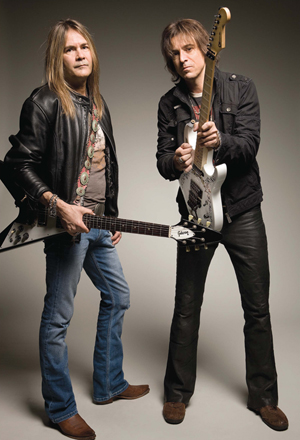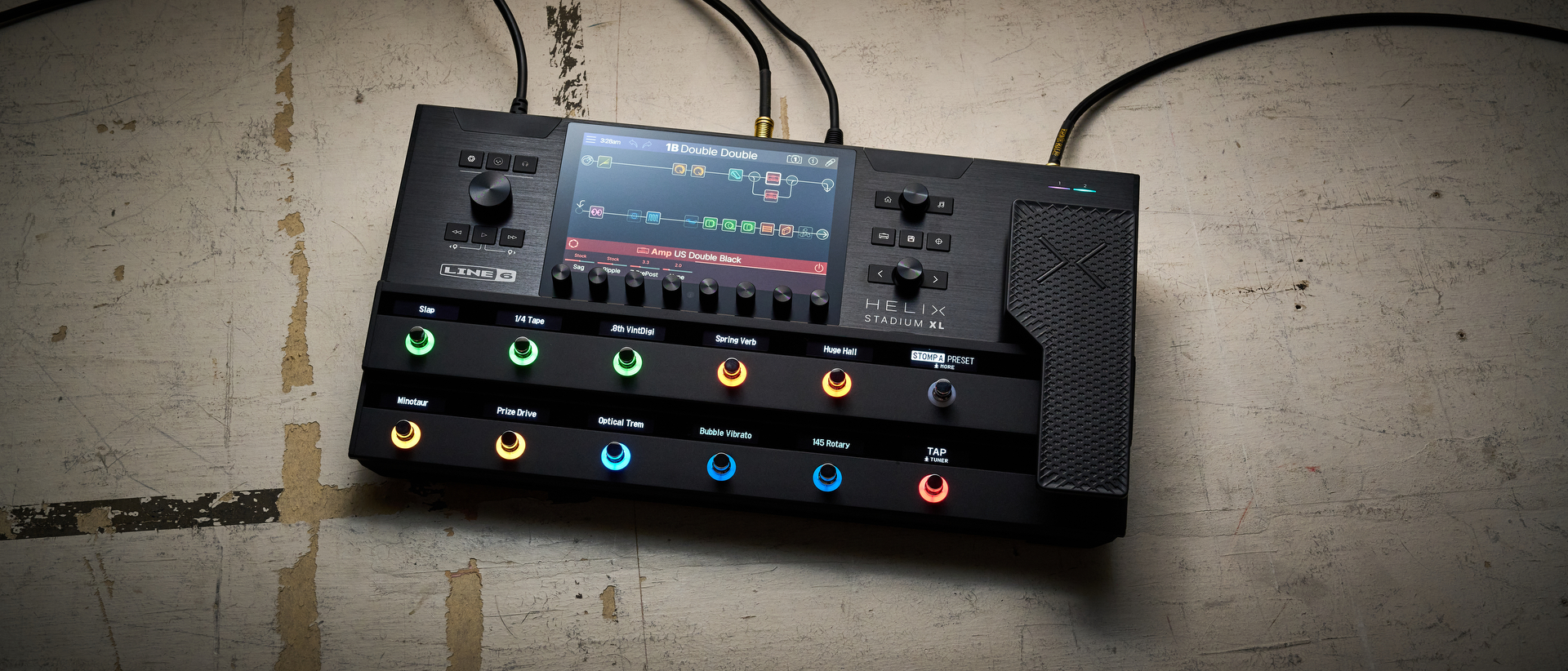Ratt: Back For More

Originally published in Guitar World, August 2010
On Ratt's latest album, Infestation, longtime guitarist Warren
DeMartini teams up with former Quiet Riot guitarist Carlos Cavazo and keeps the Eighties hair metal franchise rocking on.
Oh, the Eighties. Those were fun times: big hair, big guitar riffs, exuberant songs and scantily clad women groovin’ to the music. The genre of hard rock that came to fruition during that period, now nostalgically dubbed “hair metal,” was everywhere—on top of the charts, on MTV and radio, and at a concert venue near you. The bands, many of which emanated from the Los Angeles glam-metal scene, integrated the high-volume force of traditional metal and mixed it with hook-driven pop. From 1983 to 1989, scores of hair-metal albums were often listed near the top of the Billboard charts, thanks both to the preponderance of female fans and the success of MTV.
Ratt and Quiet Riot were among the biggest bands of that era. Though both groups fell apart—Quiet Riot in 1988, and Ratt in 1992—each eventually picked up the pieces and carried on with one lineup or another. Most recently, the star guitarists in both bands—Warren DeMartini and Carlos Cavazo, respectively—teamed up to form Ratt’s new guitar duo. Their union can now be heard on Infestation, Ratt’s first record in 11 years. The disc is a celebratory return to the band’s classic sound, packed with big, brash sing-along anthems emblematic of the group’s best work.
“The songs on this album are a logical continuation of Ratt’s mid-Eighties period,” DeMartini says. “There was a conscious effort to revisit the double-lead guitar playing that we crafted when we first became popular with albums like [1984’s] Out of the Cellar and [1985’s] Invasion of Your Privacy. But we didn’t want to make the same record over and over again, so there are some different directions and color tones on the albums we made since then. For Infestation, about the only thing we said going in was that we didn’t want to do too many overdubs. We wanted a pretty live feel to everything, and we wanted an album that had a similar energy to our best work from the old days.”
The two guitarists shared rhythm and lead duties, giving each a chance to lend his signature style to the music. Cavazo says, “On certain songs, Warren does all the guitar solos, but on other songs we both solo. Warren is definitely the main lead guitarist in this band—I’d never take that away from him—but I play a lot of the lead breaks on the album, as well.”
Producer Michael “Elvis” Baskette, who is best known for working with bands like Chevelle, Alter Bridge, Incubus and Limp Bizkit, recorded Infestation over a four-month period last year at Studio Barbarosa, just outside Virginia Beach in rural Bavon, Virginia. The studio is a beach house that’s been converted into a recording studio. “The whole band lived on the premises,” Cavazo says, “and sometimes we’d fly out and do shows on weekends. It’s a great place to record an album. From the control room you get a full 90-degree water view of Chesapeake Bay. I’d go swimming a lot, then come back and record my parts with my bathing suit on. It was totally laid-back.”
All the latest guitar news, interviews, lessons, reviews, deals and more, direct to your inbox!
That’s certainly not a term anyone would have associated with Ratt in their heyday. From 1984 to 1988, the group scored four consecutive Platinum albums (Out of the Cellar, Invasion of Your Privacy, Dancing Undercover and Reach for the Sky). In 1990, Ratt had another hit outing, the Gold-certified Detonator. But shortly after that album’s release, tensions within the band came to a head. “After Detonator, I took a long-deserved break,” DeMartini says. “After several years in a row of the album-tour-album-tour cycle, I was burned out. Playing guitar in a successful rock band was a dream come true for me, but I just needed to chill out for a while.”
The excesses of the time took a toll on the group as well. Robbin Crosby, DeMartin’s former coguitarist and the band’s main songwriter, developed a debilitating addiction to heroin and left the band in 1991. Crosby became HIV positive in 1994 and passed away in 2002 from AIDS-related complications. Together, DeMartini and Crosby had been one of the mid Eighties’ great guitar duos. Crosby would anchor the beat with his steady rhythm, providing DeMartini with the platform upon which to unleash a fluid barrage of licks. “I never would’ve been able to able to play as wildly as I did if Robbin didn’t hold the songs together,” DeMartini says. “Robbin was more of a slower, feel-type player, whereas my playing is more instinctual.”
Crosby’s illness and subsequent death robbed DeMartini of not only a playing partner but also a friend. “Robbin was a dear friend, and his death affected me deeply,” DeMartini says. “One of the dangers of this business is the temptation of drugs and alcohol, and there is a great potential for abuse. It’s something that no one expects will be a problem for them, but the nature of it is that you get too far into it before you realize what’s happened. Sadly, in an oversimplified way, that’s what happened to Robbin.”
As depicted in the Mötley Crüe autobiography, The Dirt, Crosby formed a bond with Crüe bassist Nikki Sixx, and they delved deeply, and detrimentally, into the “sex, drugs and rock and roll” lifestyle. “The stuff that ended up in that book was probably during one of the off-periods between album and tour,” DeMartini says, “so I never really witnessed firsthand what Robbin and Nikki were doing. I never stopped getting along with Robbin, but the nature of what he was struggling with made us have less and less in common.”
While Crosby’s drug use escalated, Ratt were dealing with the pressures of success. “Ratt had been a band that was just having fun playing in clubs, but we soon turned into a big business,” DeMartini says. “There would be a monsoon of work, and you’d be seeing people all the time. Then the record and tour would be done, and everyone goes back to doing their thing. There were huge gaps when I’d never see Robbin or, for that matter, anyone else from the band.”
Quiet Riot had suffered problems of their own. They had arrived on the scene in 1983 with Metal Health, a massive-selling majorlabel debut that hit Number One on the Billboard chart. Their follow-up, Condition Critical, went Platinum, but their third album, QR III, didn’t even achieve Gold. “We started off at the top and ended up at the bottom,” says Cavazo, who had joined as a replacement for Randy Rhoads, when the guitarist left to play with Ozzy Osbourne. “Our career was a succession of steps, all going down. Our producer, Spencer Proffer, led us in the wrong direction. By the second and third album, he pushed us into being a corporate rock band, which I hated. We should’ve just stayed as we were—a hard rockin’ American band.”
Ultimately, Cavazo says, what destroyed Quiet Riot’s integrity was lead singer Kevin DuBrow. “The fame and fortune got to Kevin’s head early on,” Cavazo says. “His partying got out of control and he was always ruffling feathers with people—our fans, the record company, and the band members. After our third album, we fired Kevin, because he was too difficult to deal with—he was usually whacked out of his mind. No one could deal with him anymore. He distanced a lot of people.”
After firing DuBrow, Quiet Riot recruited vocalist Paul Shortino for one album, and then disbanded. The group reformed in 1990 with DuBrow and went on to release five more albums, none of them memorable. (The last, 2006’s Rehab, didn’t feature Cavazo.) DuBrow died from a drug overdose in his Las Vegas home in 2007. “People grew to have such intense dislike for the name Quiet Riot,” Cavazo says. “We couldn’t have had another hit album no matter how good the music was, simply because Quiet Riot recorded it.”
Cavazo continued to work on various projects after leaving Quiet Riot in the mid 2000s. When guitarist John Corabi left Ratt in August 2008 to pursue a solo career, DeMartini placed a call to Cavazo to see if he would like to try out as coguitarist. DeMartini says, “About three years before I called Carlos, I actually envisioned how Ratt would work with him in the band. And then, one day out of the blue, I just took a shot and called him to see if he’d be interested. I thought it would be good to get Carlos in the band because it would be a great chance to get back to the double-guitar stuff that I did with Robbin.”
Working with Cavazo, he says, “is similar to working with Robbin in that there is an innate instinct of knowing what to do. It’s all there—the sound, the playing and the feel. There’s a certain telepathy in that things just gel. All three of us listened to the same stuff growing up—for the most part, blues-based hard rock.”
Cavazo, for his part, is glad to be working with Ratt and making the kind of music that thrilled him and so many hair metal fans back in the day. “Never in my wildest dreams did I think I’d be playing in Ratt,” Cavazo says. “But I think the world is ready for an Eighties-style rock album again. Why stray from what you do best and what made you who you are?”
